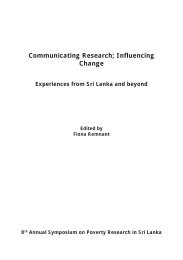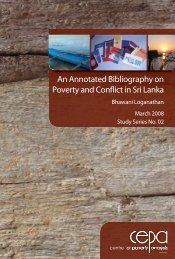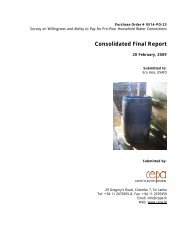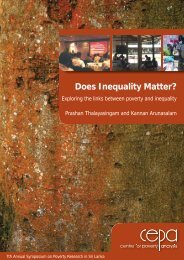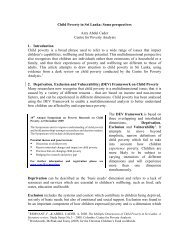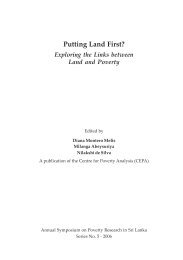Involuntary Displacement and Resettlement â Policy and ... - CEPA
Involuntary Displacement and Resettlement â Policy and ... - CEPA
Involuntary Displacement and Resettlement â Policy and ... - CEPA
- No tags were found...
Create successful ePaper yourself
Turn your PDF publications into a flip-book with our unique Google optimized e-Paper software.
controversial. People with a certain ethnic or religious identity, or belongingto a certain political party, would approach the politician who they thinkmight favour them or who they have elected to represent them at the localor national level. Many of the communities believed that politicians couldplay a more constructive role in resolving conflicts than they do at present.The study found some instances of successful intervention, which couldeasily be repeated in the district.Legal InstitutionsThe l<strong>and</strong> dispute in Palavi was the only conflict in the study sample to beaddressed by the courts. The dispute between groups of three-wheelerdrivers was addressed by the police who built a new checkpoint to deterpotential hostilities. Of the conflicts in the study, only these two wereresolved by recourse to a formal justice mechanism. The conflicting partieshad a fairly negative perception of the effectiveness of these mechanisms.The resolution provided by the courts <strong>and</strong> the police were perceived as beingbiased <strong>and</strong> ineffective. Police intervention in the form of temporary roadbarriers <strong>and</strong> checkpoints were intended as an immediate response toconflicts that were escalating into widespread social disturbance. This kind ofintervention was perceived by the public as being temporary <strong>and</strong> notaddressing the root causes of the problem. Many respondents also perceivedthe police as being biased. The decisions of the court are perceived as partialtowards certain identity groups <strong>and</strong> those who currently have more power.Successive legal challenges brought on by the different parties, <strong>and</strong> the longtime taken to resolve them, erode the effectiveness of these institutions.Development InstitutionsDevelopment institutions intervened in disputes by providing additionalresources or common property, as in the case of the disputes over the clinic<strong>and</strong> the cemetery space. Their interventions were effective in addressing theroot of the dispute. The local organisations (ISRC <strong>and</strong> RDF) that identifiedthe problems <strong>and</strong> approached the donor used their knowledge of localdynamics to diffuse situations that could easily have escalated further. Thestudy found that some projects were remarkably sensitive to the divisionsthat existed in the communities <strong>and</strong> targeted their interventions in order todistribute resources <strong>and</strong> benefits in a more equitable manner. Some projectsintervened in the conflicts studied, providing solutions that were acceptable to121



